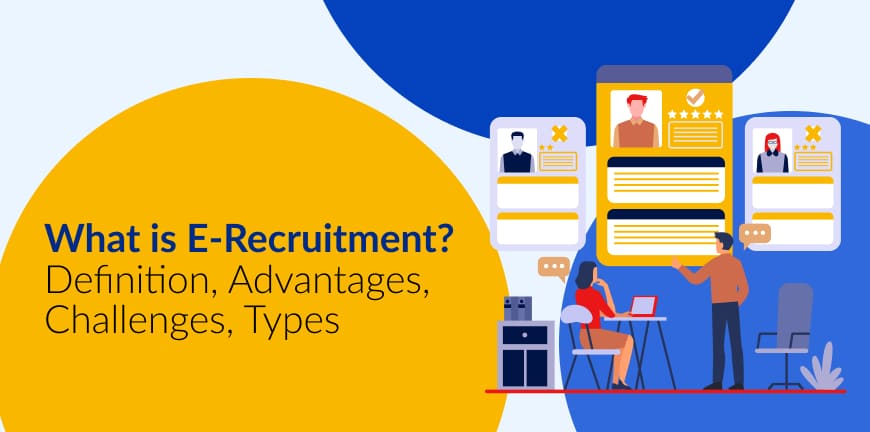
Top 10 Benefits of Hiring Remote Workers for Businesses
22/12/2025
What Is Global Payroll? Process, Challenges & Best Practices
22/12/2025- What is E-Recruitment? Meaning and Definition
- How can E-Recruitment be Conducted?
- How does E-Recruitment Work?
- What is E-recruitment in HRM?
- What are the Key Differences Between E-Recruitment and Traditional Hiring?
- What are the Advantages of E-Recruitment?
- How do you build an E-Recruitment strategy?
- What are the Challenges of E-Recruitment?
- What are the Types of E-Recruitment?
- What are the Best Tools and Platforms for Digital Recruitment?
- What is the Future of E-Recruitment in 2026?
- Are you looking for an E-Recruitment Partner?
- Key Takeaways
- Frequently Asked Questions (FAQs)
The recruitment process has drastically evolved over the past few decades. With the surge in technological advancements, businesses are constantly hunting for innovative ways to attract, hire, and retain top-notch talent. The introduction of e-recruitment has been one of the game changers in modern hiring. It is a digital revolution redefining the process of identifying the perfect fit for any role.
According to a digital hiring guide (for India) from 2024: 68% of Indian employers rely on online platforms to hire candidates, over 70% of recruiters use an applicant tracking system (ATS), and digital hiring can reduce time-to-hire by ~25-30%
What is E-Recruitment? Meaning and Definition
Now, how do we define e-recruitment? E-recruitment, also called online recruitment or digital recruitment, involves the use of technology and digital platforms to draw, evaluate, and hire candidates for various roles. Unlike traditional methods, e-recruitment mobilizes the power of the internet to reach out to a wider audience, streamline application procedures, and design an efficient and effective hiring experience.
How can E-Recruitment be Conducted?
An e-recruitment process can be conducted by optimizing digital platforms for advertising job openings, screening applicants, conducting interviews by leveraging social media and using several technological tools and strategies to manage the hiring process.
How does E-Recruitment Work?
E-recruitment strategies work when the process involves the use of technology and the Internet to attract, source, assess, select, and onboard candidates. This makes the hiring procedure streamlined. E-recruitment can be leveraged through platforms like job boards, social media, and HR software.
Let us have a look at the e-recruitment process:
- The first step is to clearly explain and determine the requirements, the specific job position, qualifications essential for an organization, along with the business objectives. According to the needs, you, as a company, with the help of the HR team, must craft a comprehensive job description to attract appropriate and talented candidates.
- The next phase for you as a business is to post job requirements as advertisements on several online platforms, career pages, social media channels, portals, etc. You must start effectively searching for suitable candidates by utilizing online networking systems and other professional sources.
- The third step is to use advanced systems to handle large volumes of applications and leverage modern technology and AI tools to screen CVs, making the process fast and smooth.
- Next is when organizations and HR initiate interviews that are likely virtual by using advanced software to conduct video conferences. They can conduct online evaluations and tests using modern tech.
- Finally, the stage of extending offers and onboarding must be initiated, and companies issue digital offer letters providing e-signature options. Apart from this, businesses complete the entire onboarding process utilising digital platforms that involve collecting relevant documents for orientation.
What is E-recruitment in HRM?
E-recruitment in HRM or Human Resource Management refers to a recruitment process that uses web-based technology over traditional methods to attract, hire, and retain top-tier candidates. Jobs are posted online by companies, then HR professionals or managers use online tools and platforms to scout for and identify potential candidates.
What are the Key Differences Between E-Recruitment and Traditional Hiring?
| Feature/Aspect | E-Recruitment (Online Recruitment) | Traditional Hiring (Offline Recruitment) |
| Method | Uses online platforms, job portals, social media, and company websites | Uses newspapers, walk-ins, job fairs, and recruitment agencies |
| Speed | Faster; instant job postings and applications | Slower; involves physical applications and manual processing |
| Cost | Generally lower; reduces advertisement and administrative costs | Higher costs for print ads, recruitment agencies, and logistics |
| Reach | Wider; can attract candidates nationally and internationally | Limited; mostly local or regional candidates |
| Application Process | Online forms, digital resumes, and automated submissions | Paper resumes, in-person submissions |
| Screening | Automated tools, AI-based matching, keyword filtering | Manual resume screening by HR staff |
| Interaction | Emails, online assessments, video interviews | Face-to-face interviews, phone calls |
| Tracking & Records | Easily track applications and maintain digital records | Harder to track manually; physical storage required |
| Candidate Experience | Quick updates, online status tracking, self-service portals | Slower feedback; less transparency for candidates |
| Flexibility | 24/7 accessibility; candidates can apply anytime | Limited by office hours and recruitment schedules |
| Data & Analytics | Provides recruitment metrics, analytics, and insights | Limited data; mostly qualitative tracking |
| Suitability | Ideal for large-scale, high-volume, and tech-savvy recruitment | More effective for niche roles, local hiring, or senior leadership |
What are the Advantages of E-Recruitment?
Let us have a look at some of the advantages of e-recruitment:
1. Cost-Efficient
The impact of e-recruitment can be immense on organizations as the method can cut down costs related to traditional recruitment methods like print advertising, travel expenses for recruiters and candidates, and recruitment agency fees.
2. Streamlined Processes
E-recruitment involves the automation of several tasks, like resume screening and application tracking. This leads to not just saving time but also resources, resulting in further cost savings.
3. Wider Talent Pool
E-recruitment’s meaning has become relevant to businesses as they have realized that they can get access to a broader pool of talent that includes applicants from different locations and backgrounds. E-recruitment tools also enable the identification and engagement of candidates who may not be actively searching for jobs but have potential.
4. Improved Communication
When we define e-recruitment we must mention that the platforms facilitate effective communication between recruiters and candidates. This ensures receiving updates and feedback on time. An online job application method is more convenient for candidates as they can apply from anywhere making the overall experience positive.
5. Data-Driven
An extensive volume of valuable and comprehensive data and analytics provided by e-recruitment platforms enables recruiters to identify trends, optimize recruitment strategies, and improve hiring decisions. Data-driven insights can identify and source the best and most qualified candidates, making more informed hiring decisions.
HCL Technologies (India) applies talent analytics tools that use natural language processing and data from over 5 million candidate and internal employee records to predict hiring success, identify skill gaps, and improve workforce planning.
How do you build an E-Recruitment strategy?
Successful e-recruitment strategies are built when you are primarily focused on designing a strong employer brand with the assistance of effective digital tools and enhancing the candidate experience throughout the entire recruitment process. Let us look at some vital elements:
1. Defining Goals
You need to first understand what your company desires and what is the key objective then partner with hiring managers to identify open roles, required skills, and preferred candidate profiles. You need to set clear goals for the recruitment efforts like reducing time-to-fill, improving application quality, or increasing diversity.
2. Robust Brand
You need to showcase your brand values and culture to build a strong employer brand image. Creating engaging content on your website, social media, and other platforms emphasizes your company’s distinctive selling points and what makes it a nice place to work. Another significant aspect is to create a comfortable and positive experience for candidates.
3. Digital Tools
It is paramount for you to utilize digital tools like Applicant Tracking System (ATS) that is attuned to your organization’s size and recruitment needs and will enable you to manage applications, filter candidates, and maintain a talent database. You must also utilize social media platforms and post on job boards.
4. Recruitment Metrics
You need to monitor key metrics like time-to-fill, cost-per-hire, and source of hire to assess and analyse the effectiveness of your e-recruitment strategy. Make informed decisions with the help of valuable data. To refine your strategy, you are required to constantly evaluate and adjust, stay competitive, and be ahead of the curve.
What are the Challenges of E-Recruitment?
E-recruitment is one of the most convenient and effective methods of recruitment. However, it has still faced a few hurdles since its inception. Let us have a look at some of the primary challenges of e-recruitment:
1. Application Volume
Online applications are convenient and comfortable, and can often lead to a spike in applications, making it impossible to handle an overwhelming volume. It becomes difficult to screen and manage candidates effectively. This can lead to numerous irrelevant or underqualified candidates making the work of recruiters painful.
2. Technical Issues
Online recruitment platforms are usually prone to technical hazards like downtime, which can impede the recruitment process. Another cause of disruption can be cybersecurity threats like data breaches and phishing attacks that can risk sensitive applicant data. Some candidates might also have inhibitions about using online applications due to security reasons.
Affect Costs
E-recruitment can sometimes escalate costs, as it is expensive to set up technology-driven e-hiring processes involving investments in training HR teams and bearing the costs of integrating new systems into the old HR systems. Then there is the issue of large volumes of applications that might require more resources to facilitate CV screening, interviewing, etc, impacting initial cost savings.
Other Disadvantages
E recruitment methods are efficient and automated methods that not only make it easier for organizations and recruiters to hire skilled employees but also make the procedures fast. However, a sketchy implementation can lead to erratic and wrong talent matching, resulting in high turnover or repetition in hiring cycles.
What are the Types of E-Recruitment?
To define e-recruitment, you need to understand that it entails several online methods to scout, identify, and recruit talent catering to the specific desires of a company. Here are a few types of e-recruitment:
1. Job Boards
There are several websites like Indeed, LinkedIn, Glassdoor, and Monster that allow companies to post job openings and draw a wide pool of candidates. Many organizations have dedicated career sections on their websites to feature job openings.
2. Social Media
Some social media platforms like LinkedIn have become very popular in terms of not just posting jobs or applying for jobs, but also expanding one’s network and connecting with people from various industries, building relationships. Other platforms like Facebook, Twitter now X, and Instagram can be used for showcasing company culture and attracting potential candidates.
3. ATS Software
These are tracking systems that help manage the recruitment process; they can help in posting jobs, tracking applications, and scheduling interviews. ATS can also automate tasks like resume screening and candidate sorting, resulting in saved resources and time.
4. Online Assessments
Online assessments can be effective in terms of evaluating the skills and abilities of candidates. There are personality assessments that can help assess if a candidate is culturally fit cultural along with identifying potential discrepancies.
What are the Best Tools and Platforms for Digital Recruitment?
For the efficient functioning and success of an e-recruitment process, reliable and effective tools must be implemented. Let us look at some of the essential tools and platforms for digital recruitment:
Zoho Recruit
Zoho Recruit is a cloud‑based recruitment solution essentially used for sourcing, interviewing, and onboarding processes. The system can automatically post vacancies to many job boards, review resumes, and offer analytics. Alp Consulting supports organizations with seamless Zogo Recruit services, streamlining processes and enhancing efficiency.
iCIMS Recruit
This is a comprehensive Applicant Tracking System (ATS) and talent acquisition suite. These systems are particularly useful for organizations with setups requiring data, dashboards, and structured processes.
Greenhouse
This is a smart recruitment platform that focuses on structured hiring, collaboration, integration, and analytics.
TurboHire
This is an AI-fuelled platform combining many recruitment activities with candidate‑matching and automation.
What is the Future of E-Recruitment in 2026?
E-recruitment is gaining momentum, and as we step into 2026 e e-recruitment will be transforming the entire hiring system. Let us look at the factors that are and will be influencing e recruitment:
1. AI and Automation on the Rise
AI will be the heart and soul of recruitment processes with AI-enabled tools systematizing operations and making processes like resume screening, interview scheduling, and onboarding fully automated and fast. Predictive analysis will be used to predict candidate performance and success rates, and retention rates.
2. Skill Centric Recruitment
The e-recruitment system is looking at a drastic change from the old systems, where the focus was essentially on degrees and past experiences. The new age recruitment systems focus on practical competencies and skills that can be demonstrated. Employers will implement online assessment and VR systems to gauge candidate performance and job capabilities.
3. Flexible Work Modes
The new norm that organizations and recruiters need to adapt to implement e-recruitment successfully is hybrid and remote work modules. With the expansion of the talent pool globally, there is a rise in the intensity of competition. It will be essential to use modern AI-powered tools to evaluate candidate profiles and applications effectively in a dispersed manpower across geographies.
4. Employer Image and Candidate Experience
The job market is highly competitive in this era, and the employer brand matters the most to candidates, and they are increasingly looking into the culture, work styles, values, etc, of a company before applying. They believe in transparency, smooth communication, and constant feedback. The expectations of candidates and how they are met by organizations can make or break their reputation.
Are you looking for an E-Recruitment Partner?
Today’s competitive job market might make it difficult for your company to find the right talent through e-recruitment. If you are in search of a reliable and efficient partner who could drive your company’s growth through e-recruitment, look no further. We at Alp Consulting have the expertise to match top-notch professionals with organizations that share a passion for innovation and success.
Key Takeaways
- E-Recruitment is Revolutionizing Modern Hiring
- Data-Driven and Technology-Powered Hiring
- E-Recruitment Offers Vital Benefits—but Also Challenges
- Building a Robust E-Recruitment Strategy Requires Clear Goals and Branding
- The Future of E-Recruitment is AI-Driven, Skill-Focused, and Candidate-Centric
Frequently Asked Questions (FAQs)
1. What are the standard Tools and Platforms Used in E-Recruitment?
The most common tools and platforms used in e-recruitment entail online job boards, Applicant Tracking Systems (ATS), video conferencing tools, and social media platforms, enabling candidate sourcing, screening, and boarding.
2. What are the disadvantages of E-recruitment?
E-recruitment is an efficient recruitment process; however, it comes with disadvantages like there as a major lack of personal touch, receiving large volumes of applications, and if there is a technical fault, it will be difficult to assess appropriate candidates.
3. What makes e-recruitment different from the traditional recruitment process?
E-recruitment or online hiring processes leverage digital tools. platforms and technologies to make recruitments seamless, unlike traditional methods, which rely on print media and advertising. They utilize these tools for job postings, candidate sourcing, and communication.
4. Is E-Recruitment a formal or informal procedure?
E-recruitment is a formal recruitment procedure as it uses a proper structure, like online platforms and tools, to tackle the recruitment process professionally. It is like traditional recruitment ways, but conducted online.
5. Who uses e-recruitment?
E-recruitment is used by employers, firms, and potential employees. The method is utilized to streamline the hiring process and connect top-tier talent to a slew of opportunities.
6. Is e‑recruitment part of HRM?
E-recruitment is an intrinsic part of HRM, and unlike traditional hiring, this process includes the involvement of digital and electronic platforms and advanced tools.
7. Which metrics should we track in e‑recruitment?
The metrics that should be tracked in e-recruitment are Time to Fill, Time to Hire, Application Completion Rate, Cost per Source, etc.
Contact Us For Business Enquiry

Amit Saproo
Amit Saproo is the Head of Operations at ALP Consulting with nearly 17 years of experience in Executive Search, RPO, Leadership, and IT & Engineering recruitment. He leads nationwide recruitment programs across Technology, BFSI, and R&D domains, driving strategic hiring solutions for diverse client needs. Amit excels in building and managing high-performance teams that deliver scalable, end-to-end recruitment and consulting services.




